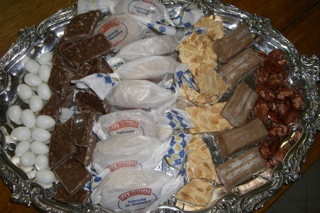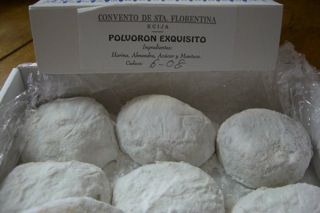SPAIN
Contributors: Concha Ruiz, Isabel González Turmo, F. Xavier Medina, Maria Jesus Portalatín, Maria-Luz Rodrigo Estevan, Luis Cantarero
Introduction: *
The modern nation state of Spain was historically divided into different kingdoms and principalities. Territorial separation led to regional diversity in many cultural aspects, including cuisine and thus food at Christmas. Despite the regional differences, this section nominally covers all of Spain, but the geographic distribution of information is uneven, based on what was presented by the contributors. In Spain generally Christmas festivities are celebrated on two main days, Christmas Eve (24th December) and Christmas Day (25th December). Depending on the region, one day is celebrated more than the other. In the centre and in the west of the peninsular, Christmas Eve is the day that is most celebrated, whereas in the east, and especially in Catalonia, Christmas Day is the main day and the most important festivity of the winter. Whichever day is the more important it is an occasion for the family to celebrate together.
Until very recently, bars and restaurants were closed on Christmas Eve in the evening. So in much of Spain the traditional meal celebrated on Christmas Eve is held at the home of one of the family members, where the table will be laid with the best cloth, crockery, cutlery, glasses, etc. Until only a few decades ago, each region had its own typical Christmas Eve menu, which would have several different courses. Where traditions of fasting are remembered, the meal should be meatless and the main course in many areas of the interior of the Peninsula would be baked sea bream. In Aragon, a traditional prior course would be cardo con pure dorado de nabos (cardoon with golden turnip purée). Other people, however, either on the 24th or the 25th celebrate with some special meat dish for the main course, and a recipe for suckling lamb is cited below, or when it was not so common as it is today, stuffed chicken might have been served. Nowadays the menu is much more varied with various shellfish, suckling lamb or pig, turkey, other poultry, or of course sea bream. For a dessert, peras al vino tinto (pears in red wine) has been exemplified. Many would then go to midnight mass, the Misa del Gallo, and return home to snack on Christmas sweets, dried fruits and wine.
As far as the menu on Christmas Day in Spain is concerned, although there has been a certain homogenisation around prestige foods, as referred to above, each region still has its own dishes. In the case of Catalonia, escudella y carn d'olla is traditional, as is also a capon, which would have to be of a special quality and farm-reared, or alternatively there might be a turkey. Such poultry would often be prepared with sweet dried fruits (such as prunes, raisins, dried apricots, etc.) and sometimes nuts, pine nuts or other seeds. In Barcelona a very popular alternative Christmas dish is canelons (cannelones cooked in the Catalan way) **.
In the villages, towns and cities of Andalucia, as in many other areas, women still carry out traditional festivities in their homes, which are sparkling with many coloured lights, etc. The days pass with over-eating. Grandmothers prepare a spicey ham soup or even a roast turkey now, and remember the years of their childhood when Christmas Eve was still a day of fasting and abstinence for Catholics. It was the day of the Misa del Gallo, not a day of feasting. The main family meal was then on Christmas Day in the middle of the day. Also of course, there were no Christmas trees, crayfish dishes, no trays of Serrano ham, nor all the tapas which today cover the table on Christmas Day. Today on the table there tends to be more food than places laid, because families are smaller. When these grandmothers were young they did not eat turkey but celebrated with a chestnut stew and polvorones (see below). Their mothers would have saved these hidden in a bedroom cupboard amongst the clean linen, so that the children didn't find them before the correct day. Nowadays children begin to eat them in October and are bored of them by Christmas.
Common across Spain, and in fact across Europe, indulging in sweet things is associated with the Christmas festivities. For Spain mention must be made of a diversity of turrones (turrons, a kind of nougat, of Arabic origin), made basically of ground almonds, sugar and sometimes honey; some also have a little white of egg. Turrons may be hard or soft; they may contain whole almonds, hazelnuts or other nuts, pine kernels or dried fruits. Traditionally the variation was regional but modern production and marketing techniques make a range of turrons available in most areas (and even outside of Spain). However, in the countryside, in Aragon and probably elsewhere, some villagers still make their own turrons in the locally traditional way. Also marzipan and polvorones. People also eat all sorts of dried fruits (raisins, dates and figs, etc.) and nuts (almonds, walnuts, hazelnuts, etc.)
Photograph (c)2008 Isabel González Turmo
A range of Christmas sweets traditional in Spain
The convents of Andalusia retain the tastes of Christmas on the walls of their cloisters. Nearly all convents have their own speciality sweetmeat, made by the nuns of well-known religious orders. When selling these sweets the nuns remain invisible to their clients because transactions are carried out through a revolving hatch. The client calls and hears a voice from behind the hatch, saying 'Ave Maria purisima', to which he or she should answer 'Sin pecado concebida'. A large selection of sweetmeats may be available - polvorones, mantecados, glories, piñonadas, hojaldrinas, roscos de vino, castañas de marzipan, pestiños de mile, bocaditos almendra and all sorts of turrons. All are sweets made of sugar, almonds and flour, with maybe egg, maybe lemon, maybe sesame seeds, maybe cinnamon, and they may be baked or fried. Similar recipes are found in Mediaeval Andalusian records, and are very like those of the Magreb. Although the sweets made by the nuns are by no means cheap, people believe they are well worth the price; 'after all it's only once a year and the sweets made by the nuns are the best!' The nuns are aware of this and have started selling the sweets in gourmet shops and even on the internet. From the beginning of Advent the time of penitence should start, and the nuns even allow others to sell their sweets in the streets and squares of the cities. In places, clients queue for hours to buy them. To get hold of these sweets is a task of love, for which one should not consider time.
Photograph (c)2008 Isabel González Turmo
Polvorones from the Convent of Sta. Florentina
The discussion of these festive foods is not complete without mention of wines and cider. Generally red wines are served with the meat dishes and white for fish and seafood. In Catalonia the festive, bubbly white wine Cava is plentifully served over the Christmas period.
In Catalonia and in some areas of the Levante, the traditional festivity of Saint Stephen's day (January 26th) is still maintained, while it has been lost in other places, such as Valencia. Generally, people feast on the usually abundant leftovers from the previous day.
Finally, one should mention the importance of January 6th, Twelfth Night, Epiphany, Dia de Reyes, in Spain. While in Anglo-Saxon countries Father Christmas/Santa Claus brings presents on the night of Christmas Eve to be found on Christmas morning, in Spain the Three Kings leave children presents to be found on the morning of January 6th. Later there would be a family lunch and for dessert in many areas people would eat the typical Epiphany cake, Roscón de Reyes, a ring-shaped cake decorated in different ways. There may be a little surprise hidden inside the cake, which is reminiscent of the customs mentioned under the Christmastime traditions of so many European countries, seemingly reflecting the traditions of the Roman Saturnalia.
* (c)Copyright 2008 Isabel González Turmo, F. Xavier Medina, Maria Jesus Portalatín, Concha Ruiz, Maria-Luz Rodrigo Estevan, Luis Cantarero, Helen Macbeth. Permission is hereby granted to reproduce and distribute copies of this Introductionto recipes for Spain solely for the purposes of non-profit domestic use or non-profit educational purposes in either case provided that copies are distributed at or below cost and that the author's source and copyright notice are included on each copy.
** This is due to the very close relationship historically between Barcelona and many Italian regions; in fact Catalonia, and in particular Barcelona, has developed a very interesting and original cuisine of pasta.

